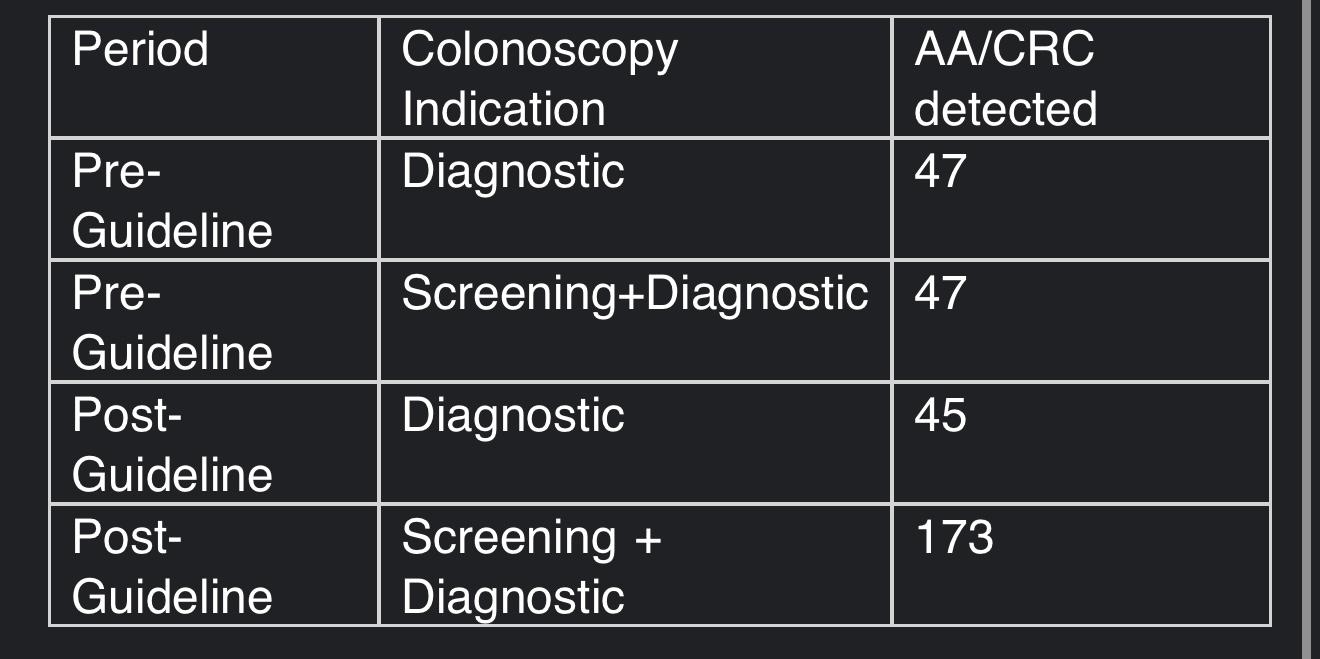Monday Poster Session
Category: Colorectal Cancer Prevention
P2643 - Comparison of Screening-Detected vs Symptom-Detected Advanced Adenoma/Colorectal Cancer in the 45-49-Year-Old Age Group at a Community Hospital
Monday, October 27, 2025
10:30 AM - 4:00 PM PDT
Location: Exhibit Hall

Abhishek Shahapurkar, MD
Mount Auburn Hospital, Harvard Medical School
Windsor, VT
Presenting Author(s)
Abhishek Shahapurkar, MD1, Ross R. Matson, MSN, APN, NP2, John Perry, MD1, Kinnari Kher, MD1
1Mount Auburn Hospital, Harvard Medical School, Cambridge, MA; 2Mount Auburn Hospital, Cambridge, MA
Introduction: In May 2021, the American College of Gastroenterology (ACG) and USPSTF lowered the recommended colorectal cancer (CRC) screening age from 50 to 45, driven by rising early-onset CRC rates. Advanced adenomas (AAs) are high-risk precursor lesions that offer a critical window for prevention. Our study aims to compare the incidence of AA/CRC in this age group for the indication of diagnostic colonoscopy before the guidelines were revised, versus diagnostic and screening colonoscopy after revision of the guidelines at our community hospital.
Methods: We conducted a retrospective observational study of patients aged 45–49 who underwent colonoscopy between June 2017–May 2021 (pre-guideline) and June 2021–March 2024 (post-guideline). EMR chart review and pathology data were used to identify polyps, classify histology, and define advanced adenomas (≥10 mm tubular, sessile serrated adenoma/polyp, traditional serrated adenoma; any size tubulovillous, villous; presence of high grade dysplasia) or colorectal cancer (intramucosal carcinoma, invasive cancer). Hyperplastic polyps were excluded. Colonoscopy indications were categorized as screening or diagnostic. Detection rates were calculated.
Results: 806 patients undergoing colonoscopy were identified in the first group. Of these, 47 were found to have at least one AA/CRC. In the second group, 2561 patients were identified. Of these, 173 were found to have AA/CRC. These results indicated an increase in the AA/CRC detection rate from 5.8% to 6.8% in this population of 45-49 year olds (Table 1). The most common histology found was tubulovillous adenoma.
Discussion: Lowering the CRC screening age to 45 significantly increased colonoscopy uptake and led to meaningful detection of advanced adenomas and early-stage CRC. A substantial proportion of high-risk lesions were identified in asymptomatic patients, reinforcing the real-world value of early screening in average-risk adults under 50. Community-level data supports guideline implementation and highlights the need for continued surveillance and data capture in this age group. Further studies could be directed towards the location, morphology and pathology of polyps in this age group.

Figure: Incidence of Advanced adenoma or CRC before and after guideline implementation
Disclosures:
Abhishek Shahapurkar indicated no relevant financial relationships.
Ross Matson indicated no relevant financial relationships.
John Perry indicated no relevant financial relationships.
Kinnari Kher indicated no relevant financial relationships.
Abhishek Shahapurkar, MD1, Ross R. Matson, MSN, APN, NP2, John Perry, MD1, Kinnari Kher, MD1. P2643 - Comparison of Screening-Detected vs Symptom-Detected Advanced Adenoma/Colorectal Cancer in the 45-49-Year-Old Age Group at a Community Hospital, ACG 2025 Annual Scientific Meeting Abstracts. Phoenix, AZ: American College of Gastroenterology.
1Mount Auburn Hospital, Harvard Medical School, Cambridge, MA; 2Mount Auburn Hospital, Cambridge, MA
Introduction: In May 2021, the American College of Gastroenterology (ACG) and USPSTF lowered the recommended colorectal cancer (CRC) screening age from 50 to 45, driven by rising early-onset CRC rates. Advanced adenomas (AAs) are high-risk precursor lesions that offer a critical window for prevention. Our study aims to compare the incidence of AA/CRC in this age group for the indication of diagnostic colonoscopy before the guidelines were revised, versus diagnostic and screening colonoscopy after revision of the guidelines at our community hospital.
Methods: We conducted a retrospective observational study of patients aged 45–49 who underwent colonoscopy between June 2017–May 2021 (pre-guideline) and June 2021–March 2024 (post-guideline). EMR chart review and pathology data were used to identify polyps, classify histology, and define advanced adenomas (≥10 mm tubular, sessile serrated adenoma/polyp, traditional serrated adenoma; any size tubulovillous, villous; presence of high grade dysplasia) or colorectal cancer (intramucosal carcinoma, invasive cancer). Hyperplastic polyps were excluded. Colonoscopy indications were categorized as screening or diagnostic. Detection rates were calculated.
Results: 806 patients undergoing colonoscopy were identified in the first group. Of these, 47 were found to have at least one AA/CRC. In the second group, 2561 patients were identified. Of these, 173 were found to have AA/CRC. These results indicated an increase in the AA/CRC detection rate from 5.8% to 6.8% in this population of 45-49 year olds (Table 1). The most common histology found was tubulovillous adenoma.
Discussion: Lowering the CRC screening age to 45 significantly increased colonoscopy uptake and led to meaningful detection of advanced adenomas and early-stage CRC. A substantial proportion of high-risk lesions were identified in asymptomatic patients, reinforcing the real-world value of early screening in average-risk adults under 50. Community-level data supports guideline implementation and highlights the need for continued surveillance and data capture in this age group. Further studies could be directed towards the location, morphology and pathology of polyps in this age group.

Figure: Incidence of Advanced adenoma or CRC before and after guideline implementation
Disclosures:
Abhishek Shahapurkar indicated no relevant financial relationships.
Ross Matson indicated no relevant financial relationships.
John Perry indicated no relevant financial relationships.
Kinnari Kher indicated no relevant financial relationships.
Abhishek Shahapurkar, MD1, Ross R. Matson, MSN, APN, NP2, John Perry, MD1, Kinnari Kher, MD1. P2643 - Comparison of Screening-Detected vs Symptom-Detected Advanced Adenoma/Colorectal Cancer in the 45-49-Year-Old Age Group at a Community Hospital, ACG 2025 Annual Scientific Meeting Abstracts. Phoenix, AZ: American College of Gastroenterology.
